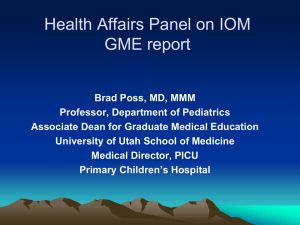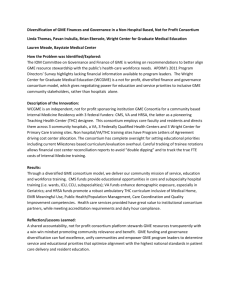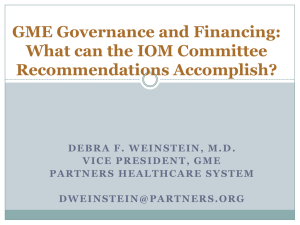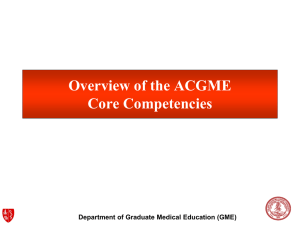AMERICAN COLLEGE OF EMERGENCY PHYSICIANS
advertisement
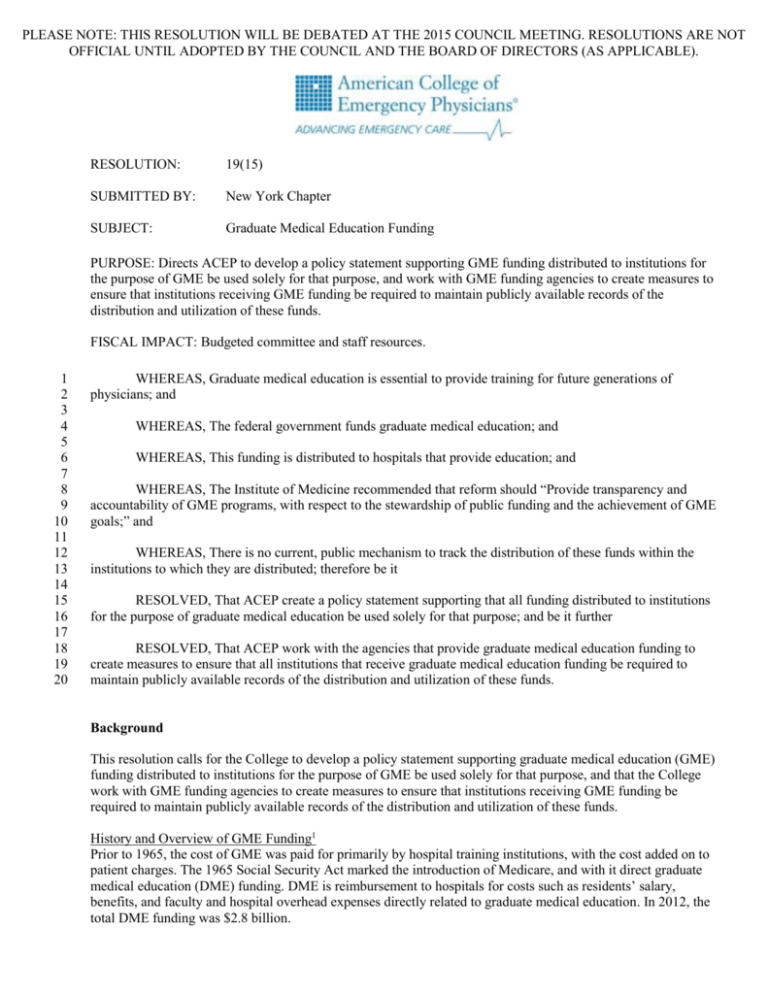
PLEASE NOTE: THIS RESOLUTION WILL BE DEBATED AT THE 2015 COUNCIL MEETING. RESOLUTIONS ARE NOT OFFICIAL UNTIL ADOPTED BY THE COUNCIL AND THE BOARD OF DIRECTORS (AS APPLICABLE). RESOLUTION: 19(15) SUBMITTED BY: New York Chapter SUBJECT: Graduate Medical Education Funding PURPOSE: Directs ACEP to develop a policy statement supporting GME funding distributed to institutions for the purpose of GME be used solely for that purpose, and work with GME funding agencies to create measures to ensure that institutions receiving GME funding be required to maintain publicly available records of the distribution and utilization of these funds. FISCAL IMPACT: Budgeted committee and staff resources. 1 2 3 4 5 6 7 8 9 10 11 12 13 14 15 16 17 18 19 20 WHEREAS, Graduate medical education is essential to provide training for future generations of physicians; and WHEREAS, The federal government funds graduate medical education; and WHEREAS, This funding is distributed to hospitals that provide education; and WHEREAS, The Institute of Medicine recommended that reform should “Provide transparency and accountability of GME programs, with respect to the stewardship of public funding and the achievement of GME goals;” and WHEREAS, There is no current, public mechanism to track the distribution of these funds within the institutions to which they are distributed; therefore be it RESOLVED, That ACEP create a policy statement supporting that all funding distributed to institutions for the purpose of graduate medical education be used solely for that purpose; and be it further RESOLVED, That ACEP work with the agencies that provide graduate medical education funding to create measures to ensure that all institutions that receive graduate medical education funding be required to maintain publicly available records of the distribution and utilization of these funds. Background This resolution calls for the College to develop a policy statement supporting graduate medical education (GME) funding distributed to institutions for the purpose of GME be used solely for that purpose, and that the College work with GME funding agencies to create measures to ensure that institutions receiving GME funding be required to maintain publicly available records of the distribution and utilization of these funds. History and Overview of GME Funding1 Prior to 1965, the cost of GME was paid for primarily by hospital training institutions, with the cost added on to patient charges. The 1965 Social Security Act marked the introduction of Medicare, and with it direct graduate medical education (DME) funding. DME is reimbursement to hospitals for costs such as residents’ salary, benefits, and faculty and hospital overhead expenses directly related to graduate medical education. In 2012, the total DME funding was $2.8 billion. Resolution 19(15) Graduate Medical Education Funding Page 2 In 1983, the inefficiencies of resident physician practice and the higher complexity of patients seen in academic institutions gave rise to justification of an adjustment or additional funding to DME, termed indirect medical education (IME). Indirect medical education adjustment (IME) covers the higher operating costs to hospitals from teaching activities including increased lengths of stay & higher acuity patients ($6.8 billion nationally in 2012). Examples of this include maintaining burn centers, trauma systems and other high-cost advanced technology that academic medical centers provide for the education of residents and fellows and the care of the community. Federal (Medicare) and state (Medicaid) funding of GME is broken into DME and IME payments. As part of several Congressional Acts these payments have become more standardized, and each institution’s number of resident or fellow trainee spots reimbursed through this system is “capped” at a specific number. Both DME and IME are distributed to hospitals that direct the funds to support residency training through a variety of mechanisms. Many of the complex changes to this system have been made due to governmental projections of physician supply needs and the notion of public financial support for academic training centers that historically provide a disproportionate share of free and advanced care for patients. The most recent of the government-sponsored projects is the July 2014 Institute of Medicine (IOM) report, “GME that Meets the Nation’s Health Needs,” that suggests several significant changes to the process of federal funding. For most emergency medicine (EM) residency programs, the Centers for Medicare & Medicaid Services (CMS) provides the majority of DME and IME funding to their program through their clinical institutions. In addition, 41 states provide some funds through CMS for GME training; the federal government provides approximately 50% of the state’s GME cost obligation so the state can match these funds if they choose, providing nearly $4 billion in support. The institution’s resident activity is reported to CMS through the Intern Resident Information System (IRIS), which most hospitals are currently calculating from resident duty hour logs. Hospitals are paid for the approved time and activity of residents up to the number of resident positions assigned to the hospital for each DME and IME positions. The hospital is paid the full amount for a resident only during the time required for training in the first specialty in which they start residency training. For emergency medicine, an institution would be paid in full for the first three years of training and only 0.5 FTE for any further years of training in EM, even for a 1-4 year EM program. Similarly, for a fellow in an Accreditation Council of Graduate Medical Education (ACGME) or American Osteopathic Association (AOA)-approved fellowship, CMS will only pay half of the normal DME for the resident since they are training for more years than the minimum allowed for that specialty. Many facilities employ more than the number of residents allowed under their cap in order to assure they receive all funds possible from CMS if the activities of one resident (an international rotation or remediation time) are not paid for in full. A hospital cannot double bill CMS for a fellow as an attending supervising in the ED and get paid for their employment as a fellow in the same field. Institute of Medicine (IOM) Report2 The IOM committee noted there is not a lot of good data on the economic impact of GME on teaching hospitals. It is not clear what “indirect costs and indirect benefits” are to teaching institutions and so it is not known what the impact is on the bottom line for these institutions. The committee also considered the economists’ perspective that residents, not teaching sites, bear the cost of their training by accepting low salaries that reflect (on average) the difference between the value of services they provide and the cost of the training they receive. (Beckier, 1964; Chandra et al., 2014 Newhouse and Wilensky, 2001) Relevant Recommendations from the IOM Report RECOMMENDATION 1 Maintain Medicare graduate medical education (GME) support at the current aggregate amount (i.e., the total of indirect medical education and direct graduate medical education expenditures in an agreed-on base year, adjusted annually for inflation) while taking essential steps to modernize GME payment methods based on performance, to Resolution 19(15) Graduate Medical Education Funding Page 3 ensure program oversight and accountability, and to incentivize innovation in the content and financing of GME. The current Medicare GME payment system should be phased out. RECOMMENDATION 2 Establish a GME Center within the CMS with the following responsibilities in accordance with and fully responsive to the ongoing guidance of the GME Council: Management of the operational aspects of GME Medicare funding; Data collection and detailed reporting to ensure transparency in the distribution and use of Medicare GME funds. RECOMMENDATION 4 Modernize Medicare graduate medical education (GME) payment methodology: Replace the separate indirect medical education and direct GME funding streams with one payment to organizations sponsoring GME programs, based on a national per- resident amount (PRA) with a geographic adjustment. Redirect the funding stream so that GME operational funds are distributed directly to GME sponsoring organizations. o Implement performance-based payments using information from Transformation Fund pilot payments. HRSA Response to IOM Report In its 2014 report, “The Role of Graduate Medical Education in the New Health Care Paradigm,” the Health Resources and Services Administration’s (HRSA) Council on Graduate Medical Education (COGME) recognizes the” logistical complexities associated with drawing conclusions about expenses and investments in physician training…transparency around the allocation of federal support, how programs use such funds, and the outcomes they achieve, could inform policy and drive program performance. However, linking program cost information with outcomes metrics requires a level of financial disclosure that even the most forth-coming training programs may find difficult, if not impossible, to provide.” IHI’s Response to IOM Report The Institute for Health Care Improvement’s (IHI) response to the IOM report: In general, the C-suite of academic medical centers (AMCs) and the AMC's designated institutional officer (DIO) and residency program director do not have a coordinated plan to harness the time, energy, and creativity of the resident workforce in accelerating progress towards making care better, safer, and more cost-effective. Often, neither the program directors nor the residents are even aware of the AMC's quality and safety goals, let alone encouraged and enabled to align their activities to these goals. AMA’s “Accelerating Change in Medical Education” Initiative: A 2014 American Medical Association (AMA) study found that transparency in quality, performance and financial involvement is central to high achievement. ACEP Policy on GME Funding ACEP’s policy statement, “Financing of Graduate Medical Education in Emergency Medicine,” does not currently address the transparency issue or the second resolved.The policy states that: Federal GME funding should be made through a non-discretionary appropriations process. Emergency medicine should have flexibility in the use of these funds in order to train residents to practice in non-urban areas. Any government advisory or planning body examining or developing policy relating to GME reform, including financing and workforce issues, should include representation and input from the specialty of emergency medicine. Resolution 19(15) Graduate Medical Education Funding Page 4 References 1 Wagner, Mary Jo, Hans House, Stephen Wolfe, Nicholas Nacca, Josh Mugele, and Philip Shayne. ACEP’s Academic Affairs Committee paper, “GME Financing for Emergency Medicine – From the Traditional to the Innovative.” 2014. 2 Magen, Jed. “Graduate Medical Education Summary for AADPRT, AACDP, AADMSEP.” 2014 ACEP Strategic Plan Reference Develop and implement solutions for workforce issues that promote and sustain quality and patient safety. Fiscal Impact Budgeted committee and staff resources. Prior Council Action Amended Resolution 22(13) GME Funding and the Match Process adopted. Directed ACEP to continue to support the National Residency Match Program and National Matching Services processes as it currently exists; oppose the hiring of emergency medicine residents through processes outside of the National Residency Match Program and National Matching Services; support efforts of sponsoring institutions to secure adequate federal funding of Graduate Medical Education (GME) for emergency medicine and support independent financing without replacing currently funded GME positions in emergency medicine or violating the Match process to train emergency medicine residents. Substitute Resolution 26(86) adopted. Directed ACEP to explore existing information regarding the cost of teaching emergency medicine at the undergraduate and graduate level and to explore the possibility of an in-depth study concerning the cost of teaching emergency medicine at the undergraduate and graduate level and report back to the Council. Prior Board Action Amended Resolution 22(13) Graduate Medical Education Funding and the Match Process adopted. October 2012, approved revised policy statement, “Financing of Graduate Medical Education in Emergency Medicine,” reaffirmed September 2005, originally approved September 1999. Resolution 26(86) Cost of Medical Education adopted. Background Information Prepared by: Marjorie Geist, RN, PhD, CAE Academic Affairs Director Reviewed By: Kevin Klauer, DO, EJD, FACEP, Speaker James Cusick, MD, FACEP, Vice Speaker Dean Wilkerson, JD, MBA, CAE, Council Secretary and Executive Director
